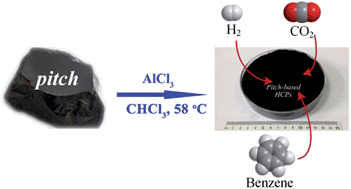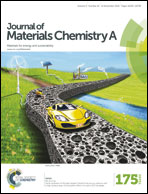Pitch-based hyper-cross-linked polymers with high performance for gas adsorption†
Abstract
A general challenge will be to reengineer porous materials where scale-up is prohibited by cost, retaining advanced functions but using cheaper and more sustainable building blocks. Every year the petro- and coal-chemical industry produces massive amounts of pitch, mainly composed of phenols, polycyclic aromatic hydrocarbons and heterocyclic compounds. We employed these previously ignored building blocks and prepared hyper-cross-linked polymers (HCPs) with a high surface area via a one-step Friedel–Crafts reaction. Depending on the place of origin, petroleum-pitch-based HCPs have a maximum BET surface area of 1337 m2 g−1 with good chemical stability. The inherent heteroatoms in the pitch (sulfur) and the introduced heteroatom (chlorine) endow the obtained HCPs with excellent gas adsorption capability. The uptake capacity for CO2 reaches up to 17.74 wt% (1.0 bar, 273 K) and the hydrogen storage is up to 1.83 wt% (1.13 bar, 77 K), which is much better than those of most reported microporous organic polymers. In addition, the pitch-based HCPs also show high organic vapor capture capacity at room temperature (cyclohexane: 1115 mg g−1; ethyl acetate: 685 mg g−1; methanol: 1198 mg g−1 and benzene: 890 mg g−1). The effective utilization of pitch for HCPs with high gas adsorption capability is essential for global sustainable development and environmental issues.



 Please wait while we load your content...
Please wait while we load your content...